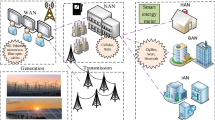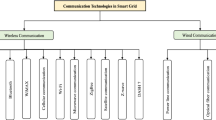Abstract
Smart grid (SG) uses bi-directional communication among the components of power system all the way from generation down to power consumers. The basic architecture of SG is comprised of multi-layered network with applications that have diverse quality-of-service (QoS) requirements. Integrating cognitive radio (CR) in SG network results in efficient handling of differential data amounts and latencies, while meeting stringent reliability requirements through cognition in the system parameters and bandwidth adaptation. Meeting data rate, reliability, and latency demands of various smart grid applications pose greater challenge in presence of uncertainty factors e.g. spectrum sensing errors, channel unavailability with desired parameters and signal-to-noise ratio etc. Spectrum sensing is the fundamental requirement of any CR-based network and this is required to identify available idle channels. Existing channel selection algorithms do not consider exact SG communication requirements simultaneously to allocate a suitable channel in accordance with some wireless standards. In this paper, we propose a technique which selects the optimum channel for the particular application, from a pool of available channels which best meets the QoS requirements. For the optimum channel selection, fuzzy inference system optimization technique is used. The physical layer is based on mode-4 of IEEE 802.22 standard, wireless regional area network. A novel approach is also proposed for allocation of channel when desired channel in not available. This approach is based on selecting an alternate channel, in event of unavailability of desired channel, with parameters that closely match with the desired requirements in order to reduce re-transmission probability. The proposed technique outperforms existing algorithms in terms of achieved latency by a minimum of 200%, and throughput by approximately 50%.














Similar content being viewed by others
References
Khan, A. A., Rehmani, M. H., & Reisslein, M. (2016). Cognitive radio for smart grids: Survey of architectures, spectrum sensing mechanisms, and networking protocols. IEEE Communication Surveys and Tutorials, 18(1), 860.
Yu, R., Zhong, W., Xie, S., Zhang, Y., & Zhang, Y. (2016). QoS differential scheduling in cognitive-radio-based smart grid networks: An adaptive dynamic programming approach. IEEE Communication Surveys and Tutorials, 18(1), 860.
Yao, L., Yang, B., Cui, H., Zhuang, J., Ye, J., & Xue, J. (2016). Challenges and progresses of energy storage technology and its application in power systems. Journal of Modern Power Systems and Clean Energy, 4(4), 519.
Otuoze, A. O., Mustafa, M. W., & Larik, R. M. (2018). Smart grids security challenges: Classification by sources of threats. Journal of Electrical Systems and Information Technology, 5, 468–483.
Kuzlu, M., & Pipattanasomporn, M. (2013). Assessment of communication technologies and network requirements for different smart grid applications. In 2013 IEEE PES innovative smart grid technologies conference (ISGT) (Vol. 1, p. 1).
Gungor, V. C., & Sahin, D. (2012). Cognitive radio network for smart grid applications. IEEE Vehicular Technology Magazine, 7(2), 41.
Alam, S., Sohail, M. F., Ghaurib, S. A., Qureshi, I., & Aqdas, N. (2017). Cognitive radio based smart grid communication network. Renewable and Sustainable Energy Reviews, 72, 535.
Yucek, T., & Arslan, H. (2009). A Survey of spectrum sensing algorithms for cognitive radio applications. IEEE Communications Surveys and Tutorials, 11(1), 116.
Sun, H., Nallanathan, A., & Wang, C.-X. (2016). Wideband spectrum sensing for cognitive radio networks: A survey. IEEE Wireless Communications, 20(2), 74.
Noorshams, N., Malboudi, M., & Bahai, A. (2010). Centralized and decentralized cooperative spectrum sensing in cognitive radio networks: A novel approach. In Proceeding of 11th international workshop on signal processing advances in wireless communications (pp. 1–5, 5172–5176).
Lu, Y., & Duel-Hallen, A. (2018). A sensing contribution-based two-layer game for channel selection and spectrum access in cognitive radio ad-hoc networks. IEEE Transaction on Wireless Communications, 17(6), 3631.
Wei, Z., & Hu, B. (2018). A fair multi-channel assignment algorithm with practical implementation in distributed cognitive radio networks. IEEE Access, 6, 14255.
Sabbah, A., Ibnkahla, M., Issa, O., & Doray, B. (2018). Control channel selection techniques in cognitive radio networks: A comparative performance analysis. Journal of Communications and Networks, 20(1), 57.
Yu, R., Zhang, Y., Gjessing, S., Yuen, C., Xie, S., & Guizani, M. (2011). Cognitive radio based hierarchical communications infrastructure for smart grid. IEEE Networks, 25(5), 6.
Qian, C., Luo, Z., Tian, X., Wang, X., & Guizani, M. (2012). Cognitive transmission based on data priority classification in WSNs for smart grid. In Proceeding of IEEE GLOBECOMM (pp. 5166–5171).
Zhou, J., Hu, R. Q., & Qian, Y. (2012). Traffic scheduling for smart grid in rural areas with cognitive radios. In Proceeding of IEEE GLOBECOMM (pp. 5172–5176).
Huang, J., Wang, H., Qian, Y., & Wang, C. (2013). Priority-based traffic scheduling and utility optimization for cognitive radio communication infrastructure-based smart grid. IEEE Transactions on Smart Grid, 4(1), 78.
Jiang, T., Wang, H., Daneshmand, M., & Wu, D. (2017). Cognitive radio based smart grid traffic scheduling with binary exponential backoff. IEEE Internet of Things Journal, 4(6), 2038.
Yu, R., Zhong, W., Xie, S., Zhang, Y., & Zhang, Y. (2016). QoS differential scheduling in cognitive-radio-based smart grid networks: An adaptive dynamic programming approach. IEEE Transactions on Neural Networks and Learning Systems, 27(2), 435.
Yousefi-khangah, B., Ghassemzadeh, S., Hosseini, S. H., & Mohammadi-Ivatloo, B. (2017). Short-term scheduling problem in smart grid considering reliability improvement in bad weather conditions. IET Generation, Transmission and Distribution, 11(10), 2521.
Nagananda, K. G., & Khargonekar, P. (2017). An approximately optimal algorithm for scheduling phasor data transmissions in smart grid networks. IEEE Transactions on Smart Grid, 8(4), 1649.
Dehalwar, V., Kalam, A., Kolhe, M. L., & Zayegh, A. (2016). Compliance of IEEE 802.22 WRAN for field area network in smart grid. In Proceeding of IEEE international conference on power system technology (pp. 1–6).
Joshi, G. P., Acharya, S., & Kim, S. W. (2015). Fuzzy-logic-based channel selection in IEEE 802.22 WRAN. Information Systems, 48, 327.
Feng, Z., Li, Q., Li, W., Gulliver, T. A., & Zhang, P. (2015). Priority-based dynamic spectrum management in a smart grid network environment. IEEE Transactions on Selected Areas in Communications, 33(5), 933.
Althunibat, S., Wang, Q., & Granelli, F. (2016). Flexible channel selection mechanism for cognitive radio based last mile smart grid communications. Ad Hoc Networks, 41, 47.
Yang, S., Wang, J., Han, Y., & Jiang, X. (2016). Dynamic Spectrum allocation algorithm based on matching scheme for smart grid communication network. In Proceeding of IEEE international conference on computer and communication (pp. 3015–3019).
Yadav, R. N., Misra, R., & Bhagat, S. (2017). Spectrum access in cognitive smart-grid communication system with prioritized traffic. Ad Hoc Networks, 65, 38.
Haddad, M., Hayar, A. M., & Debbah, M. (2007). Spectral efficiency of cognitive radio systems. In Proceeding of IEEE GLOBECOMM (pp. 4165–4169, 5172–5176).
Communication Requirements of Smart Grid Technologies. (2010). Technical report. US Department of Energy.
Samad, T., & Annaswamy, A. M. (2017). Controls for smart grids: Architectures and applications. Proceedings of the IEEE, 105(11), 1.
Zhang, B., Lam, A. Y. S., Garca, A. D. D., & Tse, D. (2015). An optimal and distributed method for voltage regulation in power distribution systems. IEEE Transaction on Power Delivery, 30(4), 1714.
Wang, B., & Sun, K. (2016). Formulation and characterization of power system electromechanical oscillations. IEEE Transaction on Power Systems, 31(6), 5082.
Jeon, Y. (2011). QoS requirements for the smart grid communications system. International Journal of Computer Science and Network Security, 11(3), 86.
Stevensen, C. R., Chouinard, G., Lei, Z., Hu, W., Shellhammer, S. J., & Caldwell, W. (2009). IEEE 802.22: The first cognitive radio wireless regional area network standard. IEEE Communication Magazine, 47(1), 130.
IEEE LAN/MAN Standards Committee. (2012). Part 15.4: Low-rate wireless personal area networks (LR-WPANs), amendment 3: Physical layer (PHY) specifications for low-data-rate, wireless, smart metering utility networks (p. 80).
Parihar, S. S., Malik, N., et al., (2017). Multi-objective optimization with non-convex cost functions using fuzzy mechanism based continuous genetic algorithm. In 4th IEEE Uttar Pradesh section international conference on electrical, computer and electronics (pp. 1–5).
Balasubbareddy, M., Sivanagaraju, S., & Suresh, C. V. (2015). Multi-objective optimization in the presence of practical constraints using non-dominated sorting hybrid cuckoo search algorithm. Engineering Science and Technology, 18, 603.
Giupponi, L., Agusti, R., Perez-Romero, J., & Roig, O. S. (2008). A novel approach for joint radio resource management based on fuzzy neural methodology. IEEE Transactions on Vehicular Technology, 57(3), 1789.
Lo, K.-R., Chang, C.-J., & Shung, C. B. (2003). A neural fuzzy resource manager for hierarchical cellular systems supporting multimedia services. IEEE Transactions on Vehicular Technology, 52(5), 1196.
Rauma, T. (1999). Fuzzy modeling for industrial systems. Ph.D. dissertation. Espoo, Finland: VTT Publications 382.
Matinmikko, M., Rauma, T., Mustonen, M., Harjula, I., Sarvanko, H., & Mammela, A. (2009). Application of fuzzy logic to cognitive radio systems. IEICE Transactions on Communications, E92–B(12), 3572.
Abdul-Haleem, M., Cheung, K., & Chuang, J. (1995). Aggressive fuzzy distributed dynamic channel assignment algorithm. In IEEE international conference on communications (p. 1).
Baldo, N., & Zorzi, M. (2009). Cognitive network access using fuzzy decision making. IEEE Transactions on Wireless Communications, 8(7), 3523.
Al-Fuqaha, A., Khan, B., Rayes, A., Guizani, M., Awwad, O., & Brahim, G. B. (2008). Opportunistic channel selection strategy for better QoS in cooperative networks with cognitive radio capabilities. IEEE Journal on Selected Areas in Communications, 26(1), 156.
Le, H.-S. T., & Ly, H. D. (2008). Opportunistic spectrum access using fuzzy logic for cognitive radio networks. In 2nd international conference on electronics (Vol. 1, p. 240).
Oh, D., & Lee, Y. (2009). Energy detection based spectrum sensing for sensing error minimization in cognitive radio networks. International Journal of Communication Networks and Information Security, 1(1), 1.
Chang, K. (2012). Spectrum sensing, detection and optimization in cognitive radio for non-stationary primary user signals. Ph.D. dissertation. Queensland University of Technology.
Mohammadi, M., & Shaout, A. (2013). Reconfigurable implementation of fuzzy inference system using FPGA. In Proceeding of international conference on new trends in computing sciences (pp. 18–23).
Uppalapati, S., & Kaur, D. (2009). Design and implementation of a Mamdani fuzzy inference system on an FPGA. In Proceeding of 28th North American fuzzy information processing society annual conference (pp. 1–6).
Bhole, K., Agashe, S., & Deshpande, A. (2013). FPGA implementation of type 1 fuzzy inference system for intravenous anesthesia. In Proceeding of IEEE international conference on fuzzy systems (pp. 1–6).
Author information
Authors and Affiliations
Corresponding author
Ethics declarations
Conflict of interest
The authors declare that they have no conflict of interest.
Additional information
Publisher's Note
Springer Nature remains neutral with regard to jurisdictional claims in published maps and institutional affiliations.
Rights and permissions
About this article
Cite this article
Khan, M.W., Zeeshan, M. Fuzzy inference based adaptive channel allocation for IEEE 802.22 compliant smart grid network. Telecommun Syst 72, 339–353 (2019). https://doi.org/10.1007/s11235-019-00570-y
Published:
Issue Date:
DOI: https://doi.org/10.1007/s11235-019-00570-y




